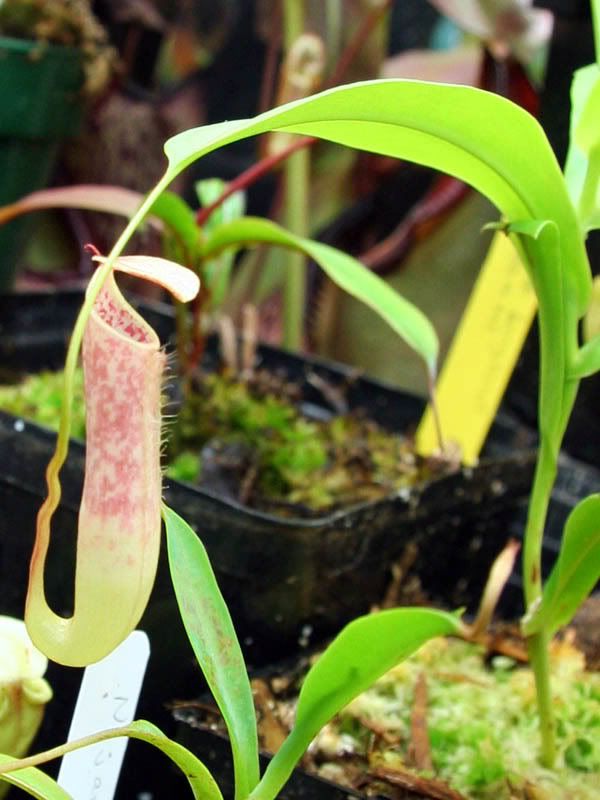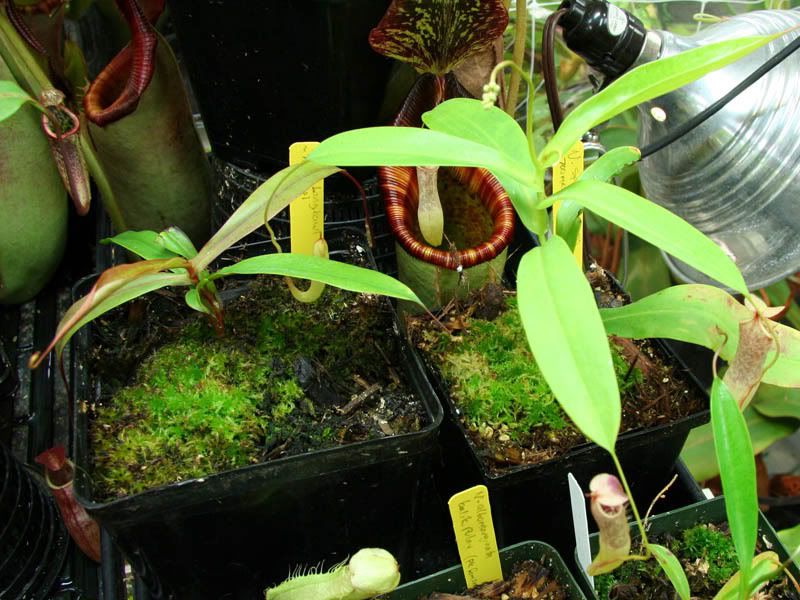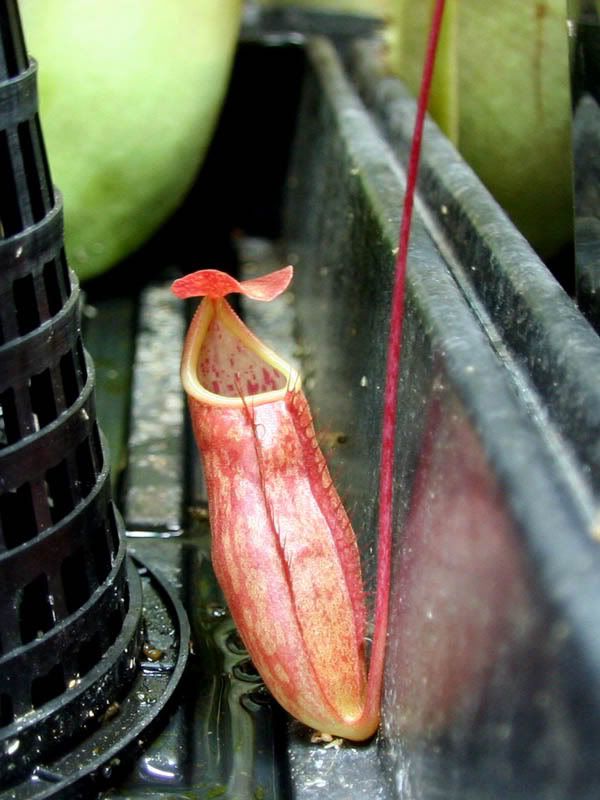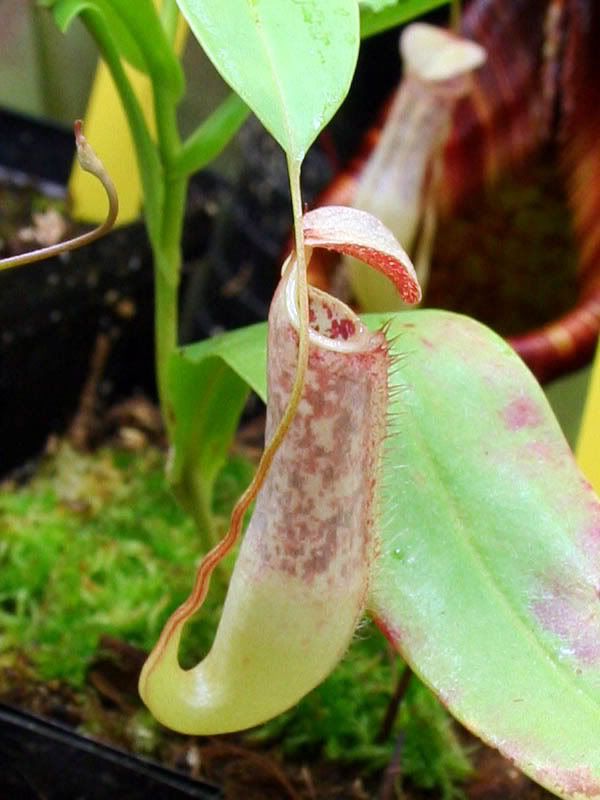|
|
Post by capslock on Aug 20, 2008 9:49:45 GMT -10
Here is the first pitcher I've got from a cutting from the species that grows on the mountain top on Langkawi Island in Malaysia.  Capslock |
|
|
|
Post by sockhom on Aug 20, 2008 9:57:29 GMT -10
Very nice Max  . This species from Langkawi is definitely related to N. smilesii. Do you grow it in pure highland conditions? François. |
|
|
|
Post by capslock on Aug 20, 2008 10:17:51 GMT -10
I do, Francois, though in summer it's more intermediate than pure highland. I have two cuttings of this - the other one is in the background (with the red stem) and seems to be ready to make a lower pitcher.
Max
|
|
|
|
Post by sockhom on Aug 20, 2008 10:41:58 GMT -10
Thanks for the quick reply, Max.
I would be very interested to see the pictures as the cuttings develop.
Would you be kind enough, when you have spare time, to take some close ups of taxonomical features such as lid shape, gland distribution, leaf attachement, indumentum, peristome, leaf lamina... ?
Some of us would be very interested to know more about this gracile and elegant species.
François.
|
|
|
|
Post by capslock on Sept 22, 2008 14:14:38 GMT -10
Update. In something of a surprise, one of my two clones of "N. sp. Langkawi" has decided to flower. It's a very small cutting still, but with a hearty and healthy root system, so I think I'll let it develop. It's just a little flower, too, as you can see. The two plants in the next picture are the two clones, which you can see are making lowers on the left, and uppers on the right, flowering plant. At least I think these are the same species, as I've never seen both lowers and uppers on the same plant. Anyway, here are the pics: Flowering plant (looks pretty male to me):  The two clones:  Pitcher from the left plant. It just opened this weekend, so it will probably darken yet.:  Pitcher from the flowering plant:  And just for comparison, here are some of the pitchers I found at the location these plants originated from:    Max |
|
|
|
Post by gre3nmind on Sept 22, 2008 17:57:52 GMT -10
Very Nice!
|
|
|
|
Post by unclemasa on Sept 22, 2008 22:57:02 GMT -10
Very interesting Max. Thanks for showing us.
|
|
|
|
Post by rainforest on Sept 23, 2008 7:03:06 GMT -10
Do you know at what elevation this species comes from? For a H/L species it does appear to have the characteristics of a lowland species. Which translates to no specialized features. More H/L species needs to adopt far out features to attract and capture their prey.
Interesting species and congrats of a first bloom. Wish there were more around to make seeds of this rarely seen species.
M
|
|
|
|
Post by capslock on Sept 23, 2008 7:10:46 GMT -10
Thanks guys. Michael, the elevation was around 700msl. It is found only at the very peaks on Langkawi's tallest mountains. I would guess it was 80-84 degrees when I was up there, and down at sea level it didn't cool off much at night. My guide says it does cool down up there, but my guess is that it doesn't go much below 70. I'm currently growing them in 58-82 degrees without complaint, but my amateur analysis is that these are lowland-intermediate plants. I have my fingers crossed that the other one is female! Here's a pic of the mountains - it was one of those peaks:  Max |
|
|
|
Post by rainforest on Sept 23, 2008 9:31:48 GMT -10
There are probably many many more species up there. Each peak has its own climate characteristic and I bet there will be a lot of speciation going on there.
Thanks for the focus on this one.
M
|
|
|
|
Post by frogsintn on Sept 25, 2008 21:05:39 GMT -10
some people have all the luck
|
|
Dave Evans
Nobiles
   dpevans_at_rci.rutgers.edu
dpevans_at_rci.rutgers.edu
Posts: 490
|
Post by Dave Evans on Sept 25, 2008 21:55:24 GMT -10
This species from Langkawi is definitely related to N. smilesii. Do you grow it in pure highland conditions? Dear François, I'm not so sure I can agree with this... I can see several differences between the two morphologically. Lets check on the ecology: Max, do you know if this area is prone to wild fires during the dry season? Most often plants species occur together with other companion species often though the whole range, even when there are gaps. What else grows with N. smilesii? What types of plants where found growing next to this species? I recall this plant is a climber with long tendrils. N. smilesii is a scrambler with short tendrils... |
|
|
|
Post by sockhom on Sept 26, 2008 9:59:30 GMT -10
Hi Dave,  I'm not saying this plant is N. smilesii. I'm just saying it is a related species. I can see some differences too. François. |
|
|
|
Post by capslock on Sept 27, 2008 10:23:10 GMT -10
Hey guys,
Dave, the guide (who didn't know nepenthes well, just that they were here) specifically said that it never burned up there (I asked.). There were also no other nepenthes species present. He said that they grew in abundance from where I was on up. We didn't go further due to the incredibly steep terrain and the time of day, but he indicated they were all the same but got a bit bigger further up, which makes sense since I was on the lower edge of where they grew.
I'm not sure how to answer whether they scrambled or climbed, since they seemed to do quite a bit of both. They certainly did appear up in bushes and trees at least up to 10 feet or so, but also scrambled along the ground. It has fairly long tendrils for the most part, though my flowering cutting has tendrils that aren't so long.
We were there near the end of the dry season, and the ground was much drier than I expected nepenthes to grow in - I guess they have a serious short dry season here. I didn't see the roots of any plants on site, (and the guide took these cuttings before I could tell him he really shouldn't do that), but I wouldn't be surprised to find they are tuberous. These cuttings threw out a LOT of roots quickly, so I'm sure they anchor deep into the sandy soil up there. Oh, as far as companion species, unfortunately I'm just a rank amateur nep grower who found himself in Malaysia at a wedding, and no botanist. I couldn't tell you what it grew with.
Max
|
|
Dave Evans
Nobiles
   dpevans_at_rci.rutgers.edu
dpevans_at_rci.rutgers.edu
Posts: 490
|
Post by Dave Evans on Sept 29, 2008 13:57:41 GMT -10
I'm not saying this plant is N. smilesii. I'm just saying it is a related species. I can see some differences too. Hello Max and François, Well, if anything, it would appear to be closer to N. kampotiana (long, slight pubescent lower tendrils), but I can't quite make out the indumentum all that well in the photos... But yeah, I still see some differences between both as well. Max, thanks for the nice description. I'm just an an "amateur nep grower" myself. But I've pick up a couple of tricks in my time (helps when you hang out with biologists  ) Could you describe the hairiness of the plants? Where there is hair, where not, and what it looks like? Also, how would you describe the leaf attachment, or what other plants have you seen with the same sort of leaf bases/stems? |
|